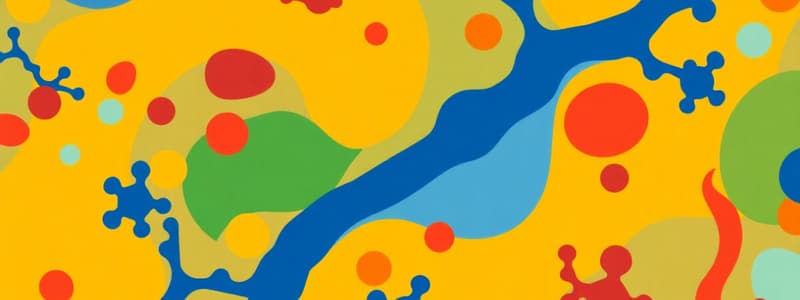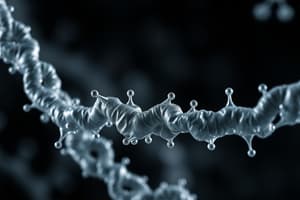Podcast
Questions and Answers
What type of bond forms between two α-glucose molecules during the condensation reaction?
What type of bond forms between two α-glucose molecules during the condensation reaction?
- 2-6 glycosidic bond
- 2-4 glycosidic bond
- 1-6 glycosidic bond
- 1-4 glycosidic bond (correct)
Which statement accurately describes amylose?
Which statement accurately describes amylose?
- It is a linear polymer of α-glucose monomers. (correct)
- It contains both 1-4 and 1-6 glycosidic bonds.
- It is a branched polymer of α-glucose.
- It is soluble in water, making it unsuitable for energy storage.
What is the primary advantage of the starch structure for energy storage?
What is the primary advantage of the starch structure for energy storage?
- It can rapidly decompose into individual glucose molecules.
- It has a compact and insoluble structure. (correct)
- It has a low molecular weight, facilitating quick energy release.
- It is highly soluble, allowing easy transport.
Which component of starch is characterized by branched α-glucose polymers?
Which component of starch is characterized by branched α-glucose polymers?
In the reaction where two α-glucose molecules combine, what is the byproduct formed?
In the reaction where two α-glucose molecules combine, what is the byproduct formed?
What type of bond primarily stabilizes the secondary structure of proteins?
What type of bond primarily stabilizes the secondary structure of proteins?
Which statement accurately describes the relationship between a protein's structure and its function?
Which statement accurately describes the relationship between a protein's structure and its function?
What is the process called that joins amino acids to form peptide bonds?
What is the process called that joins amino acids to form peptide bonds?
In which structural level of protein organization would you find interactions between multiple polypeptide chains?
In which structural level of protein organization would you find interactions between multiple polypeptide chains?
What indicates the presence of peptide bonds when using the biuret test?
What indicates the presence of peptide bonds when using the biuret test?
What structural feature is unique to triglycerides?
What structural feature is unique to triglycerides?
Which of the following accurately describes a primary function of lipids?
Which of the following accurately describes a primary function of lipids?
Which of the following types of lipids is characterized by a ring structure?
Which of the following types of lipids is characterized by a ring structure?
Which lipid type is primarily involved in forming cell membranes?
Which lipid type is primarily involved in forming cell membranes?
What role do lipids play in insulation?
What role do lipids play in insulation?
What occurs during the formation of a peptide bond between two amino acids?
What occurs during the formation of a peptide bond between two amino acids?
Which of the following roles is NOT typically associated with proteins?
Which of the following roles is NOT typically associated with proteins?
What is the primary structure of a protein defined as?
What is the primary structure of a protein defined as?
How does temperature affect the tertiary structure of a protein?
How does temperature affect the tertiary structure of a protein?
Which of the following bonds is NOT involved in maintaining the tertiary structure of a protein?
Which of the following bonds is NOT involved in maintaining the tertiary structure of a protein?
Which feature distinguishes starch from cellulose regarding branching?
Which feature distinguishes starch from cellulose regarding branching?
Which carbohydrate is classified as a polysaccharide?
Which carbohydrate is classified as a polysaccharide?
Which statement is incorrect about the properties of starch and cellulose?
Which statement is incorrect about the properties of starch and cellulose?
What type of bonds are present in both Glycogen and Starch according to the provided features?
What type of bonds are present in both Glycogen and Starch according to the provided features?
What is a unique characteristic of cellulose compared to starch?
What is a unique characteristic of cellulose compared to starch?
Which of the following is NOT a feature of starch?
Which of the following is NOT a feature of starch?
What is the role of hydrolysis in understanding carbohydrates?
What is the role of hydrolysis in understanding carbohydrates?
Which property differentiates cellulose from starch regarding plant cell walls?
Which property differentiates cellulose from starch regarding plant cell walls?
Which of the following is a true statement regarding maltose?
Which of the following is a true statement regarding maltose?
Which carbohydrate mentioned is NOT a disaccharide?
Which carbohydrate mentioned is NOT a disaccharide?
What is the role of water in the formation of a peptide bond?
What is the role of water in the formation of a peptide bond?
What type of reaction involves the breaking of a peptide bond?
What type of reaction involves the breaking of a peptide bond?
Which statement correctly describes a tripeptide?
Which statement correctly describes a tripeptide?
In the formation of a dipeptide, which groups of the amino acids are involved in forming the peptide bond?
In the formation of a dipeptide, which groups of the amino acids are involved in forming the peptide bond?
What defines a polypeptide in terms of amino acid composition?
What defines a polypeptide in terms of amino acid composition?
What is the primary function of immunological proteins?
What is the primary function of immunological proteins?
Which statement correctly describes the roles of proteins?
Which statement correctly describes the roles of proteins?
How many different amino acids are commonly used to form proteins?
How many different amino acids are commonly used to form proteins?
What distinguishes one amino acid from another?
What distinguishes one amino acid from another?
Which of the following is NOT a listed source of protein?
Which of the following is NOT a listed source of protein?
Flashcards
Glycosidic bond
Glycosidic bond
A chemical bond that links two sugar molecules together.
Glycogen
Glycogen
A complex carbohydrate made up of many glucose monomers linked together by 1-4 glycosidic bonds, found in animals.
Lactose
Lactose
A disaccharide composed of α-glucose and galactose, found in milk.
Hydrolysis
Hydrolysis
Signup and view all the flashcards
Starch
Starch
Signup and view all the flashcards
α-glucose
α-glucose
Signup and view all the flashcards
1-4 glycosidic bond
1-4 glycosidic bond
Signup and view all the flashcards
Amylose
Amylose
Signup and view all the flashcards
Amylopectin
Amylopectin
Signup and view all the flashcards
What are proteins?
What are proteins?
Signup and view all the flashcards
What are some key characteristics of proteins?
What are some key characteristics of proteins?
Signup and view all the flashcards
What are enzymes?
What are enzymes?
Signup and view all the flashcards
What is an amino acid?
What is an amino acid?
Signup and view all the flashcards
What defines an amino acid?
What defines an amino acid?
Signup and view all the flashcards
Peptide bond
Peptide bond
Signup and view all the flashcards
Condensation reaction
Condensation reaction
Signup and view all the flashcards
Dipeptide
Dipeptide
Signup and view all the flashcards
Polypeptide
Polypeptide
Signup and view all the flashcards
Protein
Protein
Signup and view all the flashcards
Primary Structure
Primary Structure
Signup and view all the flashcards
Tertiary Structure
Tertiary Structure
Signup and view all the flashcards
Secondary Structure
Secondary Structure
Signup and view all the flashcards
Quaternary Structure
Quaternary Structure
Signup and view all the flashcards
What is glycogen?
What is glycogen?
Signup and view all the flashcards
What is cellulose?
What is cellulose?
Signup and view all the flashcards
What is starch?
What is starch?
Signup and view all the flashcards
What's the main difference between starch and cellulose?
What's the main difference between starch and cellulose?
Signup and view all the flashcards
What is amylopectin?
What is amylopectin?
Signup and view all the flashcards
What are lipids?
What are lipids?
Signup and view all the flashcards
What are triglycerides?
What are triglycerides?
Signup and view all the flashcards
What is cholesterol?
What is cholesterol?
Signup and view all the flashcards
What are steroids?
What are steroids?
Signup and view all the flashcards
What are phospholipids?
What are phospholipids?
Signup and view all the flashcards




